Sukkot 2016 in Gatow
As at many beautiful Sukkot festivities previously, Anna built the framework of the Sukkah from old disused wooden pallets and battens with expert hand and skillful helpers in Rita's garden. The Ohelistas came one after the other. At the approach they were enchanted by the wonderful smell of the wood fire in Rita's and Uli's court of the Gatower remise. Cantor Jalda, the children, and all the folks of Ohel Hachidusch went to the field to harvest it enthusiastically, so that it might beautify the sukkah and our harvest festival. Many beautiful pumpkins, quinces, but also shrubbery of pumpkin for the roof of our sukkah could still be found in the field. Likewise carrots, onions, chard and fennel, as well as sage. And right, Anna, her helpers, and the children built and decorated the most beautiful sukkah Ohel Hachidusch ever had.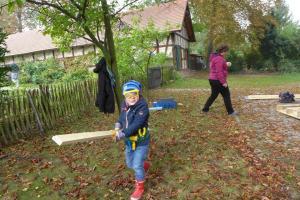

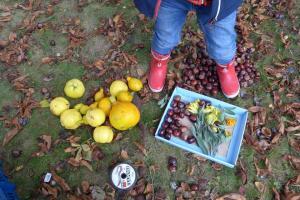
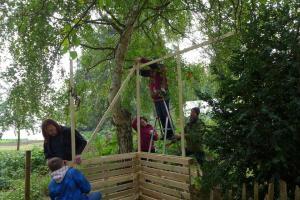


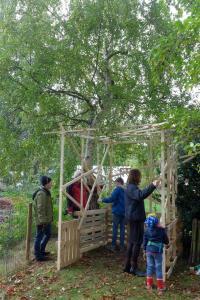
And certainly the only one in Berlin which had a pomegranate tree with fruit at the entrance.
This one, lovingly nursed by Rita Reinicke in the Botanicum, was lent to us especially for our Sukkah. The fruit is mentioned several times in the Torah. The pomegranate has 248 nuclei, as many as there are positive mitzot. With its many precious stone fruit cores, it is primarily a symbol of unity in diversity, of abundance and creative creativity, of renewal and fertility.

But before celebrating kiddush in our sukkah and the subsequent meal in Rita and Uli Reinicke´s autumnally decorated carriage house, let me add a small excursion:
No Jewish holiday is more popular among American and Israeli environmentalists than Sukkot. With its agricultural roots and its commandment to be connected to nature in provisional huts for a week, Sukkot is the sine qua non of Jewish environmental protection. What is more beautiful than what was cultivated by ourselves, eaten and drunk in a sukkah, and under seasonally appropriate fruits hanging from the roof rafters?
Every year we produce a massive Co2 footprint when we make a feast of overflow at Sukkot instead of realizing its message of living more sustainably and more in accordance with the seasons. From an environmental point of view, also etrog and lulav, the branches of the palm tree, myrtle, brookweed, the complete festive bouquet - are problematical. They are flown in from Israel and sent massively to Jewish communities, which cannot grow palm trees or etrog groves because of the winter season. The mitzvah of the arba mimin, the commandment of the use and shaking of the four species required for Sukkot, was regulated at a time and in a place where these four species were abundant, regional and renewable. When Maimonides wrote Hilchot Sukkah, in which he explained the commandment of etrog and lulav, he lived in Egypt, where etrog, palm tree, bovine pastures, and myrtle leaves were to be found as easily a good cup of coffee in Rome nowadays.
Surrounded by children, cantor Jalda stands inside the beautiful sukkah and asks the children, "Can you see the sky through the roof?" And when they say yes, Jalda declares the sukkah as kosher and says kiddush with her beautiful voice.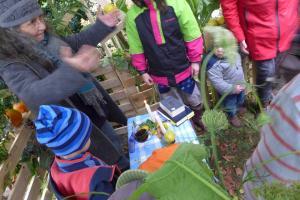

And so cantor Jalda reminded us at dinner of the tradition known to all Jews, according to which Rabbi Jochanaan said: The lulav is turned in the honor of G-d, for G-d belongs to the four heavenly directions; It is held up and down for the glory of G-d, for G-d is heaven and earth.
Just as the citrus fruit has a taste as well as a sweet smell, there are people in Israel who are both learned and live their faith.
As the fruits of the palm branch have taste but are odorless, there are in Israel people who are learned, but do not live their faith.
As the branches of myrtle have a pleasant smell, but are inedible, there are people who do good works, but are not learned.
As the branches of the brookweed are neither edible nor do they have a pleasant smell, there are people who are neither learned nor do they do good works.
But all belong together.
For, as it is said, G-d, baruch hashem,says: "Let Israel not perish, let them all be bound together, as plants are bound together, into a covenant, so that the righteous among them will effect the atonement of the others. And referring to us, cantor Jalda reminded us, that we too are often one or the other, and only together we are a blessing.
And so we used the quince of Jalda's tree on our field instead of the etrog.
For the palm branch there was a branch of a palm tree in the pot.
There was the local brookweed from Rita's garden and the myrtle from a flower pot. All these ingredients for the lulav we have picked from our field and the Botanicum.
As Anna wrote me, the idea of replacing imported plants with local ones originally came from Rabbi Jan Salzman from Vermont / USA, now Rabbi in Burlington / USA.
One more excursion to the rabbis: They say that everything that exists on earth has its spiritual counterpart in heaven. When you think about Sukkot, you wonder if G-d would have a Sukkah in a spiritual sense. And if so, what would He use for the s'chachon, for the roof above the structure? We used the cut stalks and leaves of the pumpkin plants of our field. The remains of our harvest.
During Rosh Hashanah, the days of repentance, and at Yom Kippur, we confess our mistakes and blindness before G-d.. We aim to remedy these mistakes and renew ourselves. The rabbis say that in the effort in which we transform ourselves into better human beings, abandoning the errors and doing Teshuvah, every recognized sin becomes a stepping stone for the good. Every transgression is lifted from the low place of its emergence into a position of honor, and brings us closer to G-d. Perhaps the husks and blends from which the s'chachon, the roof of G-d's Sukkah is built, are the mistakes we have made? The uglier and the lower the fault was which was expiated at Yom Kippur, the more simcha (joy) it brings to G-d's Sukkah.
That´s the way it is: When we sing and eat and drink in the shadow of the abandoned shoots of the plants of our garden and field, amidst the fruits of the field, G-d is perhaps sitting under the clippings of his vineyard and shouting a joyous le-chayim toward us. And when He does that, delighted with His harvest, He looks through the cuts of the past year and now discovers in them the blessings. And so we eat and drink gratefully in the warm, comfortable retreat in Gatow, which Rita and Uli so nicely prepared for us, devoting ourselves to Anna´s and the Ohelistas expert sukkah building arts and Jalda's beautiful voice and blessed words. We eat Rita's tasty pumpkin soup, which was boiled on a fragrant wood fire in the yard, and enjoy Rita's delicious cheesecake as well as our other home-made food and challah. Chag Sameach!
Text: Romy Koecher Photos: Anna Adam
Translation: Etha Jimenez and Joseph Reblin
